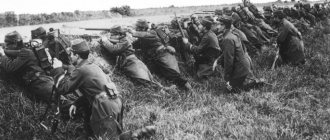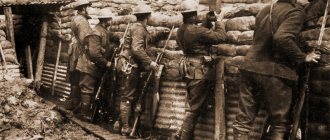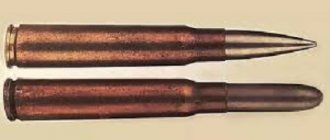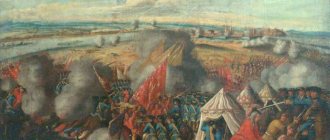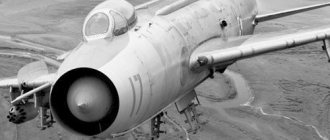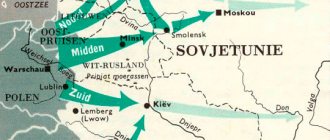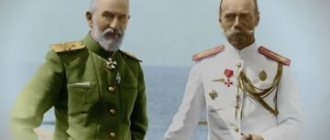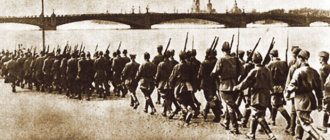↑ Progress of the war
After the defeat of the French troops in the Border Battle on August 21-25, 1914, driven by the German army, they retreated across the Marne River. Here English reinforcements headed towards them.
The German plans were to bypass Paris to the west without resorting to military operations to defend the cities there. After this, the German command was going to take the French army into the cauldron.
Battle of the Marne 1914 photo
However, being on the crest of victory, the command of the 1st and 2nd armies deviated from the original strategy and decided to go in a different direction. Thus, part of the flank remained practically defenseless, which the Anglo-French troops took advantage of and launched an active counter-offensive.
The French high command sent solid reinforcements to the Marne. Having regrouped, they found themselves in a more advantageous position. The French plan was to double cover the Germans.
The Battle of the Marne began on September 5, 1914 and lasted until September 9, 1914. The lack of a new strategy for the Germans led to the formation of a fairly large gap in the flank, where the Anglo-French alliance struck. The growth of the French army frightened the main command of the German army, which was already quite exhausted, because there was no opportunity to receive reinforcements, and the decision was made to retreat.
Battle of the Marne photo
This was very unexpected and became the “miracle” of the Battle of the Marne. After this, the French and British began to formulate a plan to invade Germany, but they were hampered by the fact that the Germans continued to control strategically important areas of France, and thus the war was stuck.
Second Marne. Part 1
In this series of articles we will talk about a series of battles combined into an operation called the Second Marne 1918 or the Second Marne July 15 - August 5, 1918. Events, as during the first Marne operation of 1914, developed in the area of the river. Marne, and in time initially took place simultaneously with the Counter-Offensive at Soissons (see In the Vanguard - the French 10th; as well as the not yet completed series of articles by Villers-Cotteret
), ending a little earlier than the Amiens operation on August 8 - 13, 1918. We examined in detail the actions of mobile troops in the latter (see Supporting armored monsters. Part 1. British cavalry in the third year of the world war; Supporting armored monsters. Part 2. Possible success?; Supporting armored monsters. Part 3. Was the result achieved?), but in the very near future we will dwell on this operation as a whole.
This article aims to examine the most critical period of operations for both warring sides in the 1918 campaign on the French front of the First World War - namely, the last great offensive of the German army towards Paris with the repeated, after 1914, withdrawal of German troops to the Marne, and a gigantic counter-offensive of the Franco-Anglo-American armies under the overall command of the commander-in-chief of the combined forces of the Entente in Europe, F. Foch.
Before considering the actual events of the Second Marne, we will give a general assessment of the military-political situation in the 1918 campaign, and also look at the result of the German Great Offensive in France in March - July 1918.
By the beginning of 1918, the situation in the countries of the German bloc had reached extreme tension. The economic nerves of four countries (Germany, Austria-Hungary, Turkey, Bulgaria) were stretched to the limit. The “quiet dictatorship” of P. Hindenburg and E. Ludendorff did not bring results, and the needs of the armed forces absorbed all the juices of these countries, which were in a state of “hunger blockade” (England continued to dominate the seas - despite active submarine warfare on the part of Germany) .
If by the beginning of 1918 in the countries of the Quadruple Alliance there was an acute shortage of food, raw materials, artificial fertilizers, and the grain collection reached 41% of the peace norm, then the production of shells increased, compared to 1914, by 15 times, guns by 20 times, and machine guns 230 times. France and England caught up with Germany in terms of military production - and France produced more aircraft than Germany ( Zayonchkovsky A. World War. Ed. 2., pp. 363, 364 and 369
).
The situation in the countries of the Triple Entente was also difficult and difficult. Russia's exit from the war had a hard impact on her. And the Entente economy was working at its limit.
For Germany in 1918, victory at the front was the only way out of the war - there was nowhere to expect material, financial and strategic assistance. For the Allies, in this regard, the situation became more and more favorable every day. Monstrously enriched in 1914-1917. The North American United States was in full swing preparing a land army for active armed participation in hostilities on the fronts of Europe.
What Germany was so afraid of was destined to come true. America, with its economic resources and army, joined the ranks of the enemies of the Quadruple Alliance. German and Austrian corps and divisions, moving for food to Romania and Ukraine, brought very little relief to the depleted economy of the German bloc, for example, a 250,000-strong mass (29 infantry and 4.5 cavalry divisions) thrown only to the occupation of Soviet Ukraine , actually fed only herself. But still this mass was temporarily excluded from the food budget of the Central Powers.
Under these conditions, politics and economics dictated to the German strategy the need to demonstrate the highest effort in order to achieve decisive success at the front before the necessary mass of American forces arrived on the continent. So, for example, on June 24, 1918, the German Secretary of State for Foreign Affairs R. von Kühlmann, speaking in the Reichstag, said that the military knot cannot be cut with a sword - a compromise must be sought. As a result, at the categorical demand of E. von Ludendorff, he was immediately dismissed. The popular phrase of F. Foch, published in 1918, is also known - “we will complete the destruction of the Boches.” From here it becomes clear that there could be no talk of any compromises - each opponent believed in his victory.
The German High Command, having weighed the current strategic situation (the withdrawal of Russia from the war - and the actual liberation of the armies in the Eastern European and Caucasian theater of operations, the successful defeat of the Romanian and Italian armies, etc.) began to create a new plan for a decisive offensive against the Anglo-French - in order to , in order to try to snatch a military victory through vigorous strikes on the Reims-Château-Thierry-Clinion front until the American troops are completely integrated into the ranks of their enemy.
Advance beyond the river Marne, the defeat of the Allied manpower, overcoming the defensive zones, entering the maneuver space and capturing the most important operational railway section - Chalons - Paris - this was the main ideological core of the strategic plan of the German command for July 1918. The author of this plan - E. von Ludendorff - sought in a new situation to accomplish what G. Moltke the Younger failed to do in September 1914.
The situation of the armed struggle was now different, operational-strategic thought was constrained by the conditions of reinforced concrete position lines - but this, as E. von Ludendorff’s experience told him, with appropriate preparation and organization, could be overcome. The March offensive towards Amiens and the May offensive towards Chateau-Thierry became a prelude to a new phase of maneuver warfare. After all, you just need to wish even more strongly and prepare even more qualitatively in all respects - in order to overcome fortifications, continuous along the front and even more powerful in depth. It was necessary to strive with all our might and means, again and again, to free ourselves from the shackles of iron and concrete with thousands of machine-gun nests and trench guns, with a mass of artillery and manpower stuck to all this - divisions that seemed to have grown into the ground and stood very tightly along the frozen front. Finally, it is necessary, through a huge accumulation of forces and technical means, through surprise, a rapid onslaught and the use of this strike in depth, to shatter these fetters and turn a positional war into a war of broad creative plans and freedom of action - into a war of maneuver.
Bearing in mind that the second Marne is only a consequence that logically followed from the previous operational-strategic activities of the German High Command and the work of its troops, we consider it advisable to remind the reader of this previous combat work of the parties.
The first in a series of large-scale German attacks was the March offensive on the river. Somme (we wrote about this in detail - see the series of articles “Michael”. March offensive of the Kaiser’s army of 1918 in France Parts 1-6
, as well as the article
“The Last Hope of Germany.
The former Russian Front and the fate of the 1918 campaign on the French Front of the First World War .
German infantry before the attack.
Soldiers cross the Aisne-Oise canal on the morning of the start of Operation Michael. The grandiose German offensive in March on both sides of the river. The Somme (from March 21 to April 9) had the main goal of defeating the British - throwing their remnants to the coast and thereby achieving separation of the main forces of both key allies on the French front. Operation Michael was the first great experience of E. von Ludendorff in his desire to free himself from the reinforced concrete shackles of positional warfare - and achieve an honorable peace by winning a war of maneuver.
Scheme 1. Disposition of the parties by March 21, 1918 and 3 offensives of E. von Ludendorff.
For his famous strike, or as some French researchers called it, a strike in the style of the “buffalo strategy,” E. von Ludendorff assembled 65 divisions in a 70 km area (Croisilles-Arras-La-Fère front). These 65 divisions of the XVII, II and XVIII armies, supported by 6,800 guns, 1,000 aircraft and 10 tanks, attacked 36 British divisions, which had 3,000 guns, 500 aircraft, 216 tanks.
The German attack was sudden. The latter was achieved not only thanks to the perfectly organized transfer of divisions to the strike area, which remained unnoticed by the enemy, but also thanks to the new method of artillery preparation applied by G. Bruchmuller (chief of artillery of the German army). The German shock divisions went on the offensive after a five-hour artillery preparation - while previously on all fronts in the last period of the world war they spent 6 or more days, losing the element of surprise.
“During the battle,” writes E. Ludendorff, “we began to fire at Paris from the Laon area with a gun with a range of 120 km. This weapon was a miracle of technology and science, a masterpiece of the Krupp company and its director Rausenberger. Part of the population left the capital, which further increased the anxiety that our successes brought.” ( "My Memories". T. II. P. 173.)
.
By the way, from the point of view of analyzing the issue of technical surprise (we wrote about this - see Paris Gun; New weapons are only half the battle) during the use of ultra-long-range artillery, the story of an eyewitness to the shelling of Paris - an English officer - artilleryman Miller, is interesting, who wrote how in 07.15.23.03.1918 The 1st shell of unprecedented force fell on the Seine embankment. 15 minutes later, a second explosion occurred on Charles V Street, and then on Strasbourg Boulevard. At first, the population decided that the bombing was taking place from a new type of airplane, invisible from the ground. A total of 21 explosions occurred that day. The metro partially ceased to function, and huge crowds of people filled the streets, peering into the sky, afraid to see supposed airplanes throwing bombs there. Another possibility seemed plausible - that the shells were fired from guns hidden in abandoned quarries or in dense wooded areas near Paris - but this also was not confirmed. According to the third theory, the projectile was fired from a pneumatic gun located within Paris itself. But soon, after examining the fragments, the allies figured out what was going on. As is known, the shelling of Paris occurred not only during the March offensive, but also during the May and July offensives. The shelling was carried out from seven 21- and 24-cm guns from the S. Gaben area (110 km). The weight of the projectile was 120 kg. Body length 19 dm. The initial speed was up to 1600 m per second, the final speed when falling in Paris was about 700 m per second, and the flight duration was about 3 minutes. In total, the Germans fired 303 shells. As significant as the moral effect was at the first moment, after a few days this shelling worried few people. Each shelling per day resulted in no more than 20 people killed and 50 wounded, while causing minor destruction.
And yet this huge mass of people and technical equipment (there was 1 infantry division, 90 - 100 guns, 15 airplanes per kilometer of front) was unable to fulfill the main task of the operation plan.
Stubborn fighting continued for about 18 days. The Allies, after several days of fighting, responded to this blow with a series of counterattacks.
25 reserve French divisions approached the battlefield. Another 15 French divisions were withdrawn here from other sectors of the front. The transfer of new forces from the Allies automatically required the same transfer from the advancing Germans.
By April 8, 25 new German divisions were also transferred to the ramming area. As a result of a series of battles over 18 days, the maximum advance in the center of the advancing front reached 65 km (with scant advance on the flanks of the breakthrough - 4 - 5 km). Thus, despite the enormous energy expended, the pace of daily progress averaged no more than 3 - 4 km.
3. The German Kaiser greets passing troops.
Nearby is the Crown Prince. Not only were the British not pushed back to the coast, but Amiens, this most important strategic junction of the railway lines to Paris and Calais (the landing port of English troops), was not taken. As a result of all their efforts, the Germans received only a bag-like expansion of the front and nothing more.
4. In the liberated village
, the maneuver of the German army, having encountered stubborn resistance from the British, and then the French who joined the latter, scattered their efforts against two opponents at once and got entangled in wire, concrete, iron, craters, mangled fortifications, by March 31, stopped at 15 km from Amiens. The German units that had gone 65 km from the starting line lived on half-starved rations - since the delivery of everything they needed was extremely difficult due to the specifics of the terrain.
The exhausted offensive impulse froze in front of Amiens, frozen here for four whole months - that is, until the August counter-offensive of F. Foch. The March offensive, having disabled about 180 thousand British with the loss of 1000 guns, also required huge sacrifices from the German army (160 thousand people) - for which, at the end of manpower, every soldier in 1918 was of particular value.
5. Throwing grenades at German trenches
The breakthrough of the Allied defenses undoubtedly turned out to be a decisive factor for the future policy and strategy of the Entente. Eternal misunderstandings and disputes regarding issues of high command were finally resolved - in April F. Foch became commander-in-chief of the allied armies. There remained one more difficult issue - the lack of manpower. But in this matter too, the German offensive was the last straw that filled America’s waiting cup. And the USA agreed to send 120 thousand infantrymen and machine gunners every month. Somewhat later, on May 2, F. Foch expressed to the American Commander-in-Chief D. Pershing the following (and very significant) plan for the use of American troops:
“The crisis that all the combatants are experiencing is, first of all, a crisis of army personnel. We need people and people. If we have them, we will win, because Germany will soon not have them. American artillery, materiel, general staff, administration and institutions can be seen later. Let the infantrymen and machine gunners arrive. On April 21st, 1918, there were 335,000 Americans in France. In April, 65,000 troops landed. Their arrival is necessary henceforth at 250,000 per month. If we lose the battle, if the British are driven back to the sea and the French to the Loire, where, when and how will the American army be formed?
As we can see, this plan does not require any special comments.
In operational-tactical terms, after the March breakthrough of the Germans, the Allies gradually began to believe in their own strength - and in the ability to respond blow to blow by maneuvering their reserves.
6. After the attack
To be continued...
↑ Consequences of the Battle of the Marne
Thanks to such a miraculous retreat of the German armies, the morale of the French rose, and they believed in the possibility of their victory. In turn, Germany's plan for a short-term war had failed; they now faced exhaustion of funds in a long struggle. An exhausting positional war began.
German literature considers the main reason for the defeat to be the weakening of part of the front during the decisive operation and the lack of agreement among the command of the German armies. The battle influenced the politics of the war: Great Britain realized the need for a major land war, and Italy abandoned neutrality and joined the Entente.
Background
After the failure of the Spring Offensive to end the conflict, Erich Ludendorff, chief of the Quartermaster General (now "second Chief of the General Staff" in rank) and military ruler of Germany, believed that an offensive through Flanders would give Germany a decisive victory over the British Expeditionary Force (BEF), the most experienced Allied formation on the Western Front at the time. To disguise his intentions and divert Allied forces away from Belgium, Ludendorff planned a major diversionary attack along the Marne.
